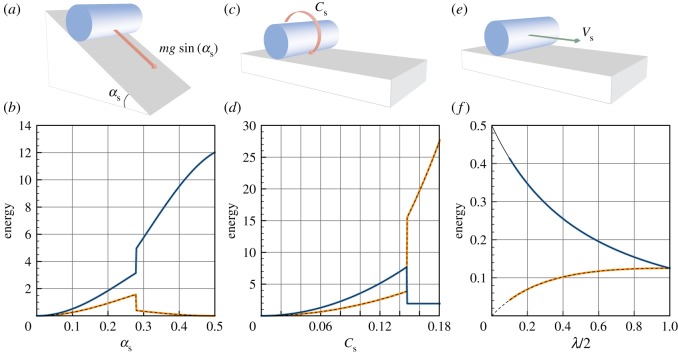Figure 17.
Rolling static and dynamic friction. (a) A rod initially at rest on a plane inclined of the angle αs rolls or slips down with linear and angular velocities v and ω due to its own weight mg. (b) Translational ET=mv2/2 (analytical solution: black line, numerical solution: blue line) and rotational ER=Jω2/2 (analytical solution: dashed black line, numerical solution: orange line) energies are plotted against the angle αs. Settings: length L=1 m, radius r= 0.025 m, mass m=1 kg, Young’s modulus E=109 Pa, shear modulus G=2E/3 Pa, shear/stretch matrix S=104×1 N, bend/twist matrix B=diag(EI1,EI2,GI3) Nm2, dissipation constant γ=10−6 kg (ms)−1, gravity g=9.81 m s−2, static and kinetic friction coefficients μs=0.4 and μk=0.2, friction threshold velocity , ground stiffness and viscous dissipation kw=10 kg s−2 and γw=10−4 kg s−1, discretization elements n=50, timestep δt= 10−6 s, simulation time T=0.5 s. (c) Rod set in motion by the external couple Cs on a horizontal plane. (d) Translational ET and rotational ER energies are plotted against the couple Cs. Colour scheme and settings are identical to those of panel (b) except for the simulation time T=1 s. (e) Rod with initial velocity V s slows down due to kinetic friction until the no slip condition is reached. (f) Translational ET and rotational ER energies are plotted against the relative mass moment of inertia ratio λ/2. Colour scheme and settings are identical to those of (b) except for the simulation time T=2 s, and the friction threshold velocity vϵ=10−6 m s−1.

